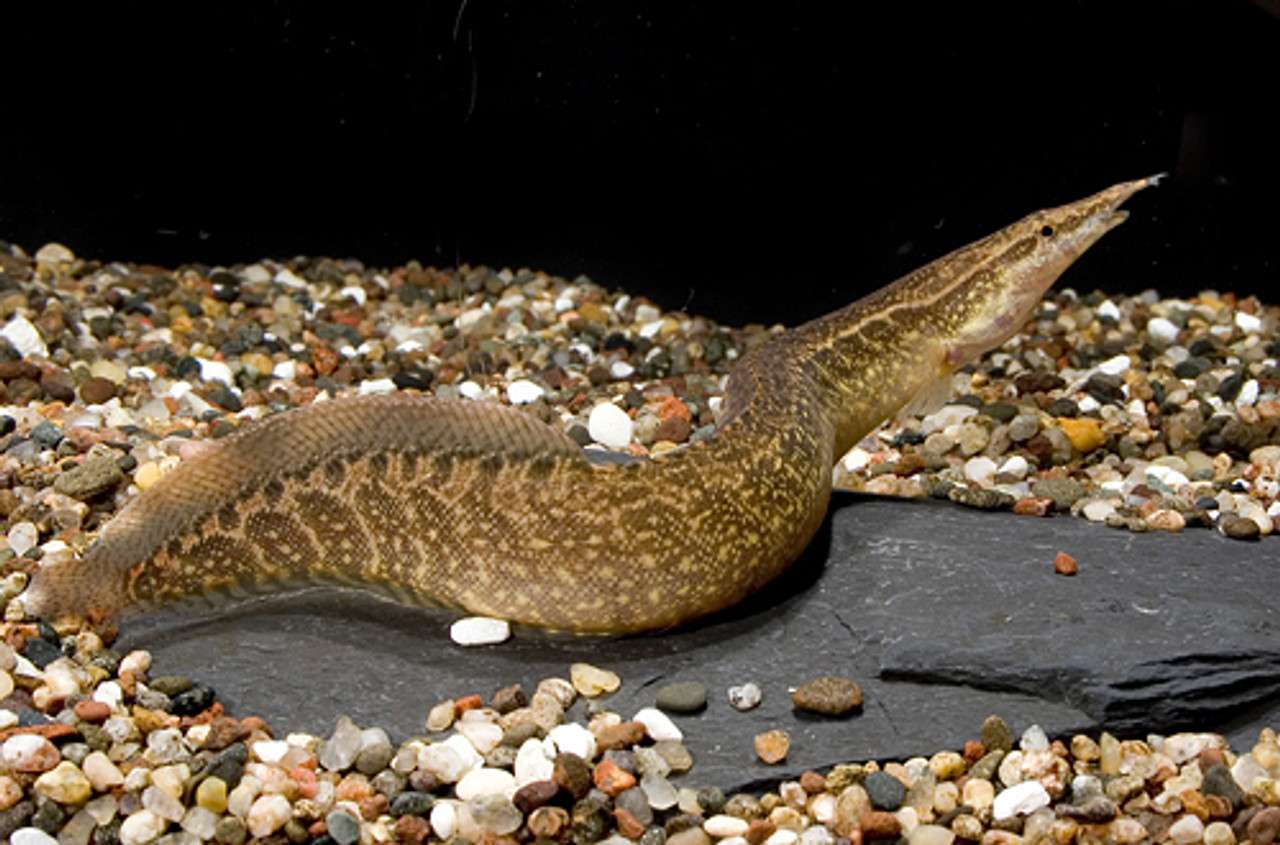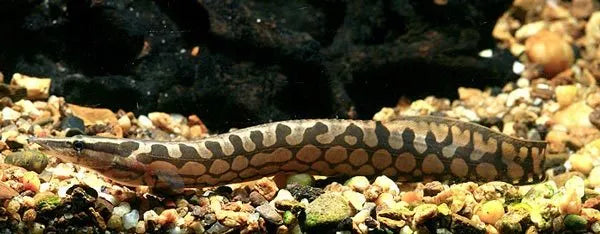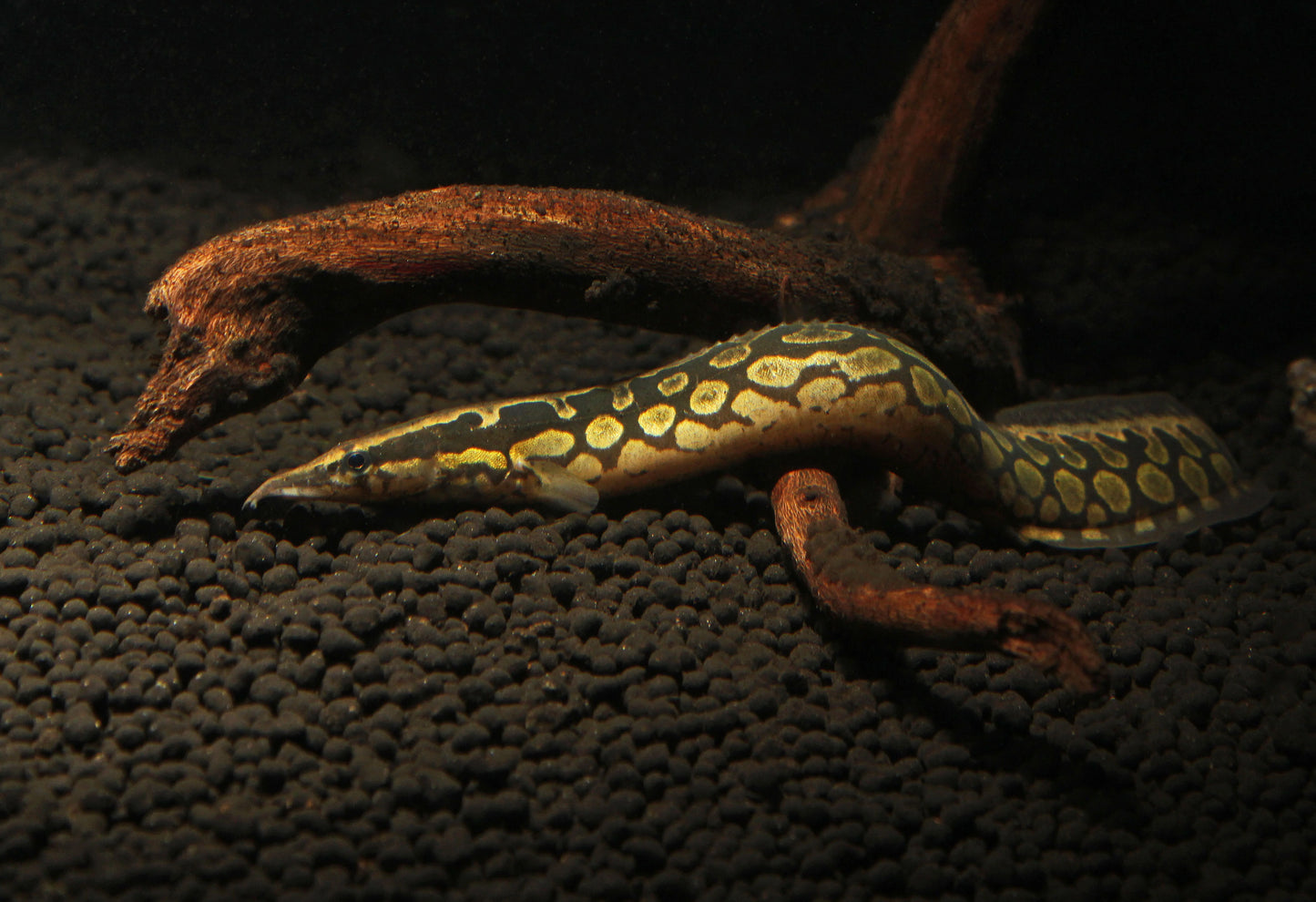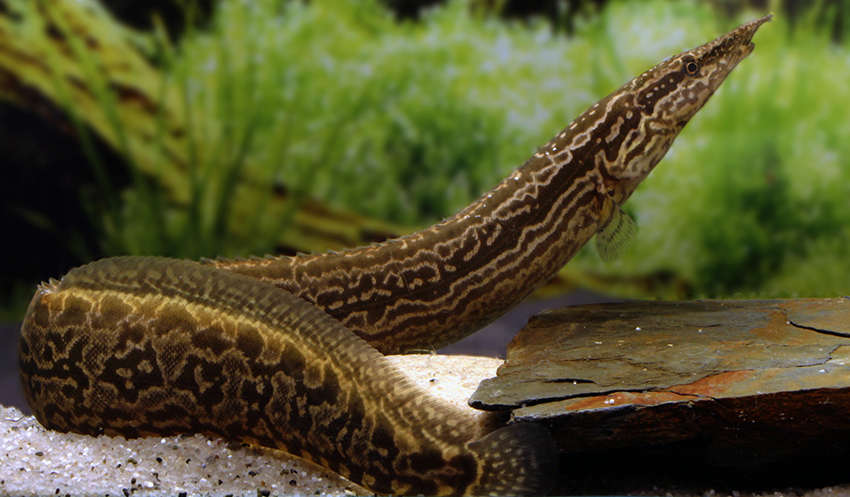Zigzag Eel (Mastacembelus armatus) - Live Fish
Zigzag Eel (Mastacembelus armatus) - Live Fish
DESCRIPTION OF ITEM:
The Zigzag Eel, (Mastacembelus armatus), is a fascinating freshwater eel native to Southeast Asia. It is sometimes referred to as the Giant Snakehead Eel due to its elongated body and its tendency to display snake-like movements. This eel species is popular in the aquarium hobby, especially for its distinctive appearance and unique behavior.
Here’s a detailed look at the Zigzag Eel:
1. Appearance
- Coloration: The Zigzag Eel has a light brown or yellowish body with dark, zigzag markings running along its length, which gives the fish its name. These markings can vary in intensity, but they typically create a striking contrast against the eel’s lighter background.
- Size: The Zigzag Eel is a relatively large species, and in the wild, it can grow up to 3 feet (90 cm) in length. However, in captivity, it tends to grow around 1.5 to 2 feet (45-60 cm).
- Body Shape: The eel has an elongated, cylindrical body with a broad, flattened head. It also has a long dorsal fin that extends from the back of its head to the tail, as well as a large anal fin. These features contribute to its serpentine, eel-like appearance.
2. Temperament
- Semi-aggressive but Peaceful: While Zigzag Eels are not inherently aggressive, they are carnivorous and will hunt smaller fish, invertebrates, and any prey they can overpower. They should not be housed with small fish that may fit in their mouth.
- Solitary Nature: Zigzag Eels are often best kept alone or with other large, robust fish. They tend to be peaceful within their own species, but they may become aggressive when competing for food.
- Nocturnal: These eels are mostly nocturnal and will often hide during the day in caves, under rocks, or in the substrate, coming out to hunt and explore at night.
3. Habitat
- Tank Size: Due to their potential size, Zigzag Eels require large tanks, typically around 75-100 gallons (284-378 liters) for one eel. A bigger tank is recommended if you plan to house other large fish with it.
- Water Conditions: Zigzag Eels thrive in slightly acidic to neutral water with a pH range of 6.5 to 7.5. The temperature should be kept between 75-82°F (24-28°C).
- Substrate: They prefer soft, sandy substrates, as they are known to burrow into the substrate, especially when they are feeling stressed or need rest.
- Filtration: A good filtration system is necessary, as Zigzag Eels can be messy eaters and produce a significant amount of waste. Clean, well-oxygenated water is essential for their health.
4. Diet
-
Carnivorous: Zigzag Eels are primarily carnivores. They feed on a variety of live and frozen foods, including:
- Small fish.
- Worms, such as earthworms or bloodworms.
- Shrimp and other invertebrates.
- In captivity, you can provide a variety of protein-rich foods, such as live or frozen brine shrimp, nightcrawlers, and blackworms. They may also accept sinking pellets and other meaty foods.
- While they may graze on algae, their primary diet should consist of animal protein.
5. Behavior and Care
- Active and Curious: Zigzag Eels are active hunters and enjoy exploring their environment, especially at night. During the day, they prefer to hide in caves or burrow in the substrate, mimicking their natural behavior.
- Burrowing: These eels love to burrow, so a soft substrate is necessary. They will often dig small tunnels or hide in the sand, where they feel more secure.
- Lifespan: With proper care, Zigzag Eels can live for 10-15 years in captivity.
6. Tankmates
-
Suitable Tankmates: Zigzag Eels can be kept with other large, semi-aggressive fish, such as:
- Larger cichlids.
- Larger catfish.
- Other large, robust species that can tolerate the eel’s predatory nature.
- Avoid Small Fish: Small, slow-moving fish are not suitable tankmates, as the Zigzag Eel may view them as potential prey.
- Invertebrates: Smaller invertebrates (like shrimp or snails) may also become prey for the eel, so be cautious when adding these to the tank.
7. Breeding
- Breeding Zigzag Eels in captivity is rare, and little is known about their breeding habits in the home aquarium. In their natural habitat, they are egg-layers, with females laying eggs on hidden surfaces. However, due to their specific environmental needs and the size of their breeding process, captive breeding is difficult.
8. Considerations
- Escape Artists: Zigzag Eels are known for being escape artists, and they may attempt to wriggle out of tanks if there are any gaps in the lid or if the tank is not securely covered.
- Tank Size and Space: These eels require ample space to move around and explore. A large tank with plenty of hiding spots (caves or driftwood) is essential for their well-being.
- Water Quality: Like many other eels, Zigzag Eels thrive in stable, clean water conditions. Regular water changes and maintaining proper filtration are necessary.
The Zigzag Eel is an interesting and exotic species that can make an impressive addition to a well-maintained aquarium. While it is relatively peaceful with large, robust tankmates, it can be predatory and should not be kept with smaller fish. Providing a large, well-filtered tank with soft substrate, secure hiding spots, and a varied diet will ensure that your Zigzag Eel remains healthy and active. With its nocturnal behavior and burrowing habits, it is a unique species that can add both beauty and fascination to your aquarium setup.
Product features
Product features
Materials and care
Materials and care
Merchandising tips
Merchandising tips
Share








